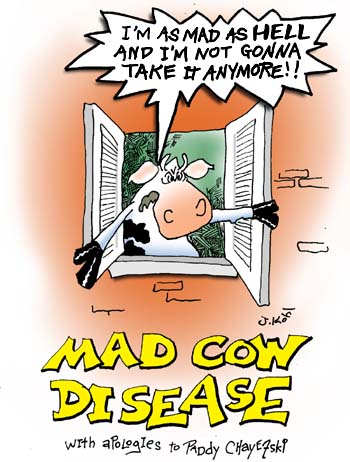 Mad cow disease has been in the headlines in recent years. While a serious illness, it primarily affects cattle and, possibly, other animals, like goats and sheep — the risk to human beings is extremely low.
Mad cow disease has been in the headlines in recent years. While a serious illness, it primarily affects cattle and, possibly, other animals, like goats and sheep — the risk to human beings is extremely low. What Is Mad Cow Disease and How Do People Get It?
The medical name for mad cow disease is bovine spongiform encephalopathy, or BSE for short. BSE is an incurable fatal brain disease. It is called mad cow disease because it affects a cow's nervous system, causing the animal to act strangely and lose control of its ability to do normal things, such as walk.
Only certain animals can get BSE — people don't actually get mad cow disease. However, experts have found a link between BSE and a rare brain condition that affects people called variant Creutzfeldt-Jakob disease (CJD). Researchers believe that people who eat products from cows that have BSE are at risk of developing a form of CJD.
CJD is caused by an abnormal type of protein in the brain called a prion. When people have CJD, cells in the brain die until the brain eventually has a "sponge-like" appearance. During this time, people with the disease gradually lose control of their mental and physical capabilities.
To date, very few people have been diagnosed with the form of CJD that's been linked to mad cow disease. By November 2006, only 200 cases of this rare condition had been reported worldwide. Of these, most were identified in Britain. Several of the people diagnosed with the disease outside Britain — including two cases in the United States — had a history of exposure in Britain or in a country where government officials reported BSE.
Because the form of CJD that's been linked to mad cow disease is relatively new and extremely rare, experts are still learning about it. However, researchers believe that the disease is not contagious among people — in other words, you can't get CJD from someone else who has it. There have been a few cases of CJD that are believed to have been transmitted through blood transfusions. At present, it appears that the main way people get the disease is from eating contaminated meat.
Experts don't yet know exactly how long the incubation period is for CJD (in other words, how long it takes from the time a person contracts it to the time that symptoms appear). However, they do believe that it takes years, if not decades, from the time someone gets the disease until the first signs appear. Once they do, the brain can deteriorate within a year.
What's Being Done About It?
BSE doesn't spread naturally from cow to cow; it's suspected to be transmitted by feeding cows animal meal. However, the U.S. Food and Drug Administration (FDA) introduced an "animal feed" rule in 1997 prohibiting the feeding of most proteins made out of mammals to ruminant animals (such as cows, sheep, and goats), which was what was thought to have begun the BSE epidemic in the United Kingdom. According to the FDA, 99% of the facilities raising cattle for human consumption are currently in compliance with the feed rule.
The type of protein that causes mad cow disease can't be removed or destroyed when beef is processed or cooked. For this reason, the U.S. government has established several procedures to protect the public. One of these involves removing the parts of the cow that are at highest risk of containing BSE-causing proteins — the brain and spinal cord — to reduce the chances of contaminating the meat people eat.
In October 2005, the FDA proposed additional safeguards to help protect consumers from BSE. These prohibit the use of any high-risk cattle materials in the feed of any animal. In this way, the FDA continues to decrease the already tiny possibility of infection with BSE.
In addition, there is a system in which samples of animals are tested. This is one way to help prevent contaminated meat from reaching the shelves. The testing system helped officials identify some contaminated meat in Washington state in December 2003 — one of only three cases of mad cow disease found in the United States so far. The government also has a recall policy in place for meat that's suspected of being contaminated.
If you're wondering if it's safe to continue drinking cow's milk, rest assured that it is — the U.S. Department of Agriculture (USDA) says there is no evidence that the disease can be transmitted through cow's milk and milk products. It's also extremely unlikely that a person will contract CJD from eating beef.
CJD itself is pretty rare — each year, only one in 1 million people in the United States die of the disease. And because only three cows in the United States have been found to be infected with mad cow disease, which can't be spread from cow to cow, the chance that you will or anyone in your family will eat meat infected with the disease is extremely low.